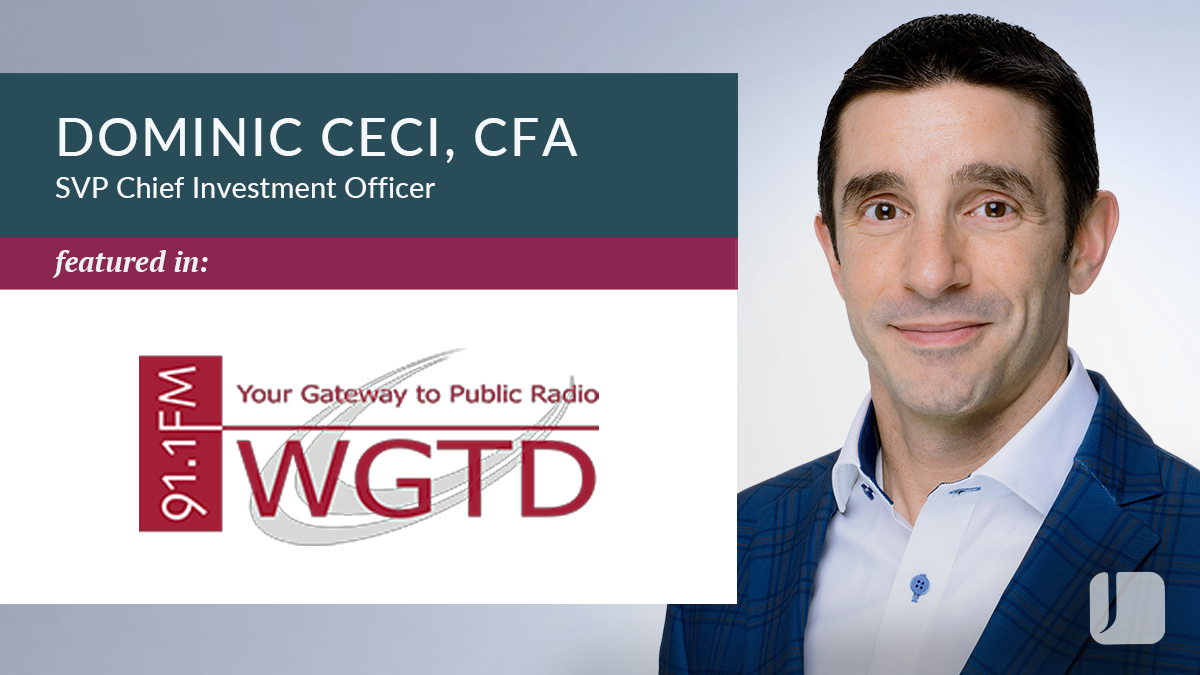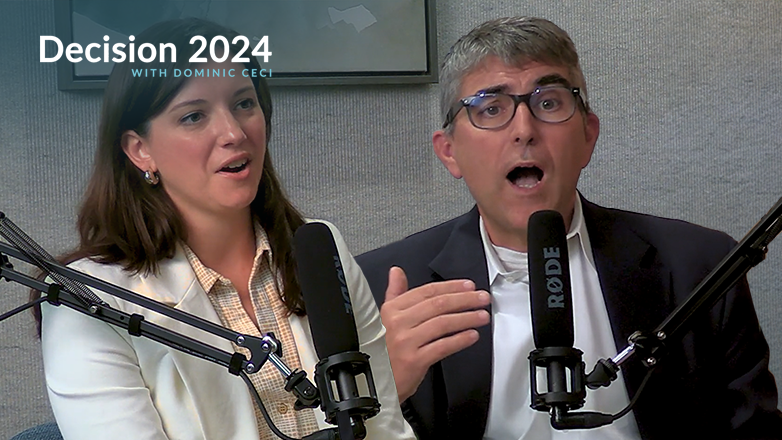SUMMARY
- The election will probably be close—and it's not a driver for investment strategy.
- AI is a real trend but challenges exist. We're still in the early innings.
- The economy is strong overall but bifurcating and slowing under the surface.
- For the markets, a long-term approach is the best way for most investors to succeed. A diversified portfolio is the best way to mitigate risk. There are always risks and scary headlines. Look at any chart of market history and you'll see plenty of negative events and uncertainty. But those things don't correlate reliably to market returns.
Last week I had the opportunity to share an economic update with clients at a breakfast event in Kenosha. Here, I’d like to share themes from my presentation.
I’ll start with the election … not because it’s particularly important for investors (historically speaking, it isn’t) but because it’s on everyone’s minds. Then I touch on artificial intelligence before reviewing a number of economic indicators and what they mean for investors going forward.
In the last section, I offer perspective on how our investment team ties all these ideas together through scenario analysis, long-term performance estimates, and ultimately portfolio allocations.
As always, all of us on the investment team welcome your questions. Please let your advisor or portfolio manager know if you’d like to discuss how any of these topics relate to your specific situation.
1. The election
Elections don't drive how we manage money. We don't set investment policy based on politics and advise that no one else should either. When having discussions about investment strategy, this is a topic you can push to the side. Here are three big reasons why:
- Pulling money out of markets to avoid elections works against you. Historically, going back to 1960, if you had invested $100,000 in the S&P 500 Index but taken the money out for six months every four years—during the second half of election years because you're worried about the impact of elections—you would have realized only half the return versus simply staying invested.
- Similarly, investing only when one party or the other is in power works against you. Since 1896, you would have missed on a return approximately 10 times higher if you’d simply stayed invested!
- Economic growth, stock market performance, and election outcomes are uncorrelated, historically. Sometimes people say a specific party will be better for a particular industry, but even that doesn't always play out how you might think.
It is prudent, though, to think a bit about the potential tax environment post-election—since the 2017 tax cuts are set to expire at the end of 2025. Either party will likely do some extensions of the 2017 tax cuts to avoid the appearance of tax increases on the middle class.
Also, the likelihood of divided government—or even, in the event of a sweep of both houses of Congress and the presidency by one party, the likelihood of Senate close to 50-50—means there will be people in place to block more extreme policies.
2. Artificial Intelligence (AI)
AI has been this decade's “smartphone moment.” It's an interesting growth story. We don't know exactly where it's going. Estimates for the impact on GDP are all over the map, from almost none to trillions within the next 10 years. What we do know is that people are spending a lot of money right now to build out AI infrastructure:
- The big winners so far have been semiconductor companies. They have very advanced technology with big moats. It takes decades to develop. They're building all the critical components and tools that everyone is either using now or says they're thinking about using.
- You have these hubs where data centers are clustered, like in Loudoun County, Virginia. If this AI revolution is going to turn into what people say it could, you need a lot of power and water to run it, which tends to favor concentrating plants where both are available. (If you're smart, you'd build data centers in a place like Wisconsin and open the windows in the winter to help with cooling.)
Actual adoption of AI right now is pretty low, around 15-20% in tech-forward industries, and closer to 7% across all industries. This leaves plenty of room for increased usage of these technologies. It's a pretty common narrative that when ChatGPT went live, it had the fastest user growth of any app ever. But what you don't often hear is that user engagement is among the lowest. People try the technology out of curiosity, play around with it, but then don't really engage with the product much after that. Given the low engagement, I’m not so sure consumers are willing to pay for premium AI products. For professional applications, the costs are still high, but the use cases and value proposition are more clear.
So, for now, the winners are the companies building the core infrastructure. There's government money behind that, and plenty of private investment too. That cash flow is real. Beyond semiconductors, energy, infrastructure, and landowners in data center hubs are among the big winners here.
3. Health of the Economy
Inflation has come way down, which is good, but unemployment has ticked up recently. The Fed lowered its benchmark rate by half a percentage point recently, largely based on the labor market data. In August, payroll jobs data for the 12 months through March of 2023 were revised down by one of the largest amounts in history at 818,000 jobs. That's a big revision, so as the revised numbers came out, the job market looked a lot weaker than initially thought. Interestingly, the latest jobs report that just came out was really good—which could complicate the Fed’s path.
Wisconsin's 2.9% unemployment rate is low for problematic reasons. The workforce participation peaked in 2017, with older workers retiring and not being adequately replaced by younger workers. Additionally, prime working-age people with families are opting out of the workforce due to high childcare costs. This has led to a tight labor market where businesses are struggling to find workers to fill open positions.
Consumer surveys show people think it's harder to find a job now than earlier in the year. If people perceive the labor market as more challenging, that may lead them to slow down spending. That said, economists are largely lining up behind the proverbial “soft landing” coming to fruition, meaning no recession in sight.
Still, cost of living is a difficult topic:
- The headline news is that inflation has come down and is close to the Fed's target. But that misses a big part of the story. Prices went up a lot and are now just going up more slowly. The fact that the price of eggs went from $2 to $3 and is now rising at a slower pace to maybe $3.20 next year doesn't change the fact that eggs are a lot more expensive than they used to be. Those higher price levels are more impactful for lower-income consumers. Those extra dollars really add up and can lead to cutting back discretionary spending.
- This is why both parties' candidates are talking about affordability. They know the high cost of living is a top issue for voters. You're starting to see the impact in things like rising credit card delinquencies and auto loan defaults. People are relying more on credit to get by, but interest rates on credit cards are as high as they've ever been. Those high rates compound, and people are starting to fall behind on payments. We're seeing the initial cracks, especially at the lower end of the income spectrum.
- If you're running a bank and see credit card and auto lending risk going up, and delinquencies starting to rise, you're going to tighten your lending standards and demand higher interest rates to compensate for that risk. And that's exactly what we're seeing. Banks are saying they need more yield to justify the risk of extending new consumer loans.
The big theme here is that the economy is bifurcating, not just for households but for businesses too. Smaller companies are having a harder time than large corporations, and a big part of that is their higher cost of borrowing. Large companies with good credit are borrowing at rates not that far above Treasury yields. But smaller, riskier companies are paying double or triple that, often on floating rate terms that increase their vulnerability. There's a big difference in how different tiers of businesses are weathering this environment.
Here are several other economic themes we’re watching closely:
- Oil prices. The electrification of everything is an ongoing theme, but oil prices still matter a great deal. If there was a major supply disruption, say from a big Middle East producer going offline, it could absolutely cause oil to spike and potentially catalyze a downturn. Oil is an input into so many things. Even if you're not using it to make a product, you're using it to transport that product to market. Oil prices also impact consumer psychology simply due to their visibility.
- Commercial real estate. Office vacancies keep climbing. There are things that can be done to repurpose obsolete office space such as converting old office buildings to residential. But it's very expensive to retrofit an office tower for housing. We'll see if Amazon and other companies follow through on requiring workers to come back to the office 5 days a week. If they do, that could help stabilize the office market. But it's a challenging situation, no doubt about it.
- Equity markets. Lower interest rates are generally good for stocks. Unemployment has ticked up but from a very low level. GDP growth is still solid and businesses are performing well. About half of the market's rise this year has been from multiple expansion rather than earnings growth. Eventually you do need rising profits to support stock prices. Elevated valuations are a sign of excitement but not necessarily sustainable. Sticky inflation or stronger employment data could give equities pause as it means the Fed has less reason to cut rates as quickly as investors are hoping for. That could take some of the froth out of the market.
- Bond markets. We're in a new, higher interest rate regime. We had over a decade of zero rates from 2008 to 2022. We're probably not going back to that ultra-low rate world, which is a good thing. When yields are below 2%, it pushes investors to stretch for yield in ways that lead to excess risk-taking in portfolios and in the business world.
4. How All This Fits Together
In our investment process, we probability-weight different scenarios:
- Let's say we think there's a 40% chance of a particular outcome. We'll do that for multiple scenarios and then construct the portfolio weighting based on the expected value of those probabilities.
- Right now, we're getting the economic soft landing that everyone has been hoping for. But something like oil spiking to $110 could change that outlook pretty quickly.
Then, as we approach portfolio construction, we look at things with a very long-term lens. That's how you win as an investor. If you try to trade short-term moves, you're likely to lose money and even if you get it right, you'll face high tax rates. So we forecast returns over 10-15 year horizons:
- We update our capital market assumptions annually, forecasting out 10-15 years.
- We expect the return outlook to flatten out, with fixed income yields staying in the current range. Equities are relatively expensive, so returns will likely be on the lower end of the historical range over the next 10-15 years.
- The good news is that bonds are in a much better position now than they were a decade ago when rates were so low. And alternative investments can be additive in this environment as well. Several opportunities in the alternative-investment space are attractive right now.
Our best advice is to stay diversified across stocks, bonds, alternatives … and ignore the impulse to make investment decisions relating to politics!
Download the Presentation


